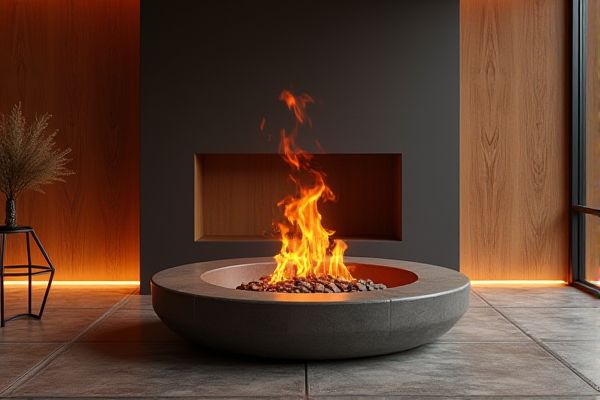
Fire bowls offer a classic, open flame experience that enhances outdoor ambiance, while fire columns provide a modern, vertical design perfect for contemporary spaces. Discover which fire feature suits Your style and space by reading the rest of the article.
Table of Comparison
| Feature | Fire Bowl | Fire Column |
|---|---|---|
| Design | Open, shallow bowl shape | Tall, vertical column shape |
| Heat Output | Broad heat distribution, moderate warmth | Concentrated heat, higher intensity |
| Visual Impact | Wide flame spread, relaxed ambiance | Vertical flame, dramatic and modern look |
| Portability | Often portable and lightweight | Usually fixed or heavier |
| Fuel Type | Wood, propane, or natural gas | Primarily propane or natural gas |
| Installation | Easy setup, minimal installation | Requires professional installation |
| Safety | Lower risk, open flame area | Higher risk, tall concentrated flame |
| Best For | Casual gatherings, outdoor relaxation | Modern patios, stylish focal points |
Introduction to Fire Bowls and Fire Columns
Fire bowls and fire columns offer distinct styles for outdoor heating, with fire bowls providing a wide, open flame ideal for social gatherings and fire columns delivering a sleek, vertical flame that enhances modern aesthetics. Fire bowls typically feature a shallow, circular design that distributes warmth evenly and serves as a focal point in patios or gardens. Your choice between these two will depend on your outdoor space design and the ambiance you wish to create.
Design Differences: Fire Bowl vs Fire Column
Fire bowls feature a wide, open design that provides a broad flame display and a traditional, rustic aesthetic, making them ideal for creating a cozy atmosphere in outdoor spaces. Fire columns, on the other hand, have a tall, vertical structure that delivers a sleek, modern look with flames rising upward, enhancing ambiance without taking up much ground space. Your choice between these two designs depends on the desired visual impact and spatial arrangement of your outdoor area.
Material Choices for Fire Features
Fire bowls often feature materials like cast iron, steel, or copper for durability and heat resistance, while fire columns typically use stainless steel or aluminum to ensure structural integrity and sleek design. Both fire features can incorporate tempered glass or stone accents for aesthetic appeal and safety. Choosing materials depends on desired heat output, weather exposure, and maintenance requirements, making metal alloys and protective coatings essential for longevity.
Heat Output and Efficiency Comparison
Fire bowls typically provide broader heat distribution with moderate output, making them ideal for casual outdoor gatherings. Fire columns concentrate heat vertically, offering higher efficiency in directing warmth to a specific area while consuming less fuel. Your choice depends on whether you prefer widespread ambient heat or focused, energy-efficient warmth.
Aesthetic Appeal in Outdoor Spaces
Fire bowls offer a wide, open flame that creates a cozy, inviting atmosphere ideal for social gatherings and outdoor relaxation. Fire columns provide a sleek, vertical flame that adds a modern, sculptural element to contemporary outdoor designs. Your choice depends on whether you prefer the traditional warmth of a fire bowl or the striking, architectural presence of a fire column.
Space and Placement Considerations
Fire bowls require a larger, open space due to their wide and low profile, making them ideal for expansive patios or gardens. Fire columns, with their tall and narrow design, fit well into smaller areas or tight corners, providing vertical flames without taking up much floor space. Your choice depends on the available space and desired visual impact, ensuring safe and functional placement.
Installation and Maintenance Requirements
Fire bowls offer straightforward installation, often requiring only a stable surface and minimal setup, making them ideal for portable or temporary use. Fire columns typically demand professional installation due to their height and integrated gas connections, ensuring safety and compliance with local codes. Maintenance for fire bowls involves regular cleaning of ashes and debris, while fire columns require periodic inspection of gas lines and ignition systems to maintain optimal performance.
Safety Features and Regulations
Fire bowls typically feature lower profiles and broader bases, reducing the risk of tipping and promoting stability, while fire columns have taller structures that may require enhanced anchoring to comply with safety regulations. Both must adhere to local fire codes, including setbacks from combustible materials and flame height restrictions, to ensure safe operation in residential settings. Safety features such as spark guards, automatic shutoff valves, and flame diffusers are essential in both designs to prevent accidental ignition and uncontrolled flames.
Cost Comparison: Fire Bowl vs Fire Column
Fire bowls generally cost less upfront, ranging from $150 to $600, while fire columns often start around $400 and can exceed $1,200 due to their vertical design and complex features. Maintenance expenses for fire columns might be higher because of additional components like burners and gas connections, whereas fire bowls require simpler upkeep. Your budget will influence the choice, with fire bowls offering a more affordable option and fire columns providing a sleek aesthetic at a premium cost.
Choosing the Right Fire Feature for Your Home
Selecting between a fire bowl and a fire column depends on your outdoor space and design preferences. Fire bowls offer a classic, open flame experience, providing warmth and a cozy ambiance ideal for social gatherings. Fire columns provide a modern, vertical flame that adds a sleek, architectural element to your patio while maximizing space efficiency, helping you enhance Your home's outdoor atmosphere.
 homyna.com
homyna.com